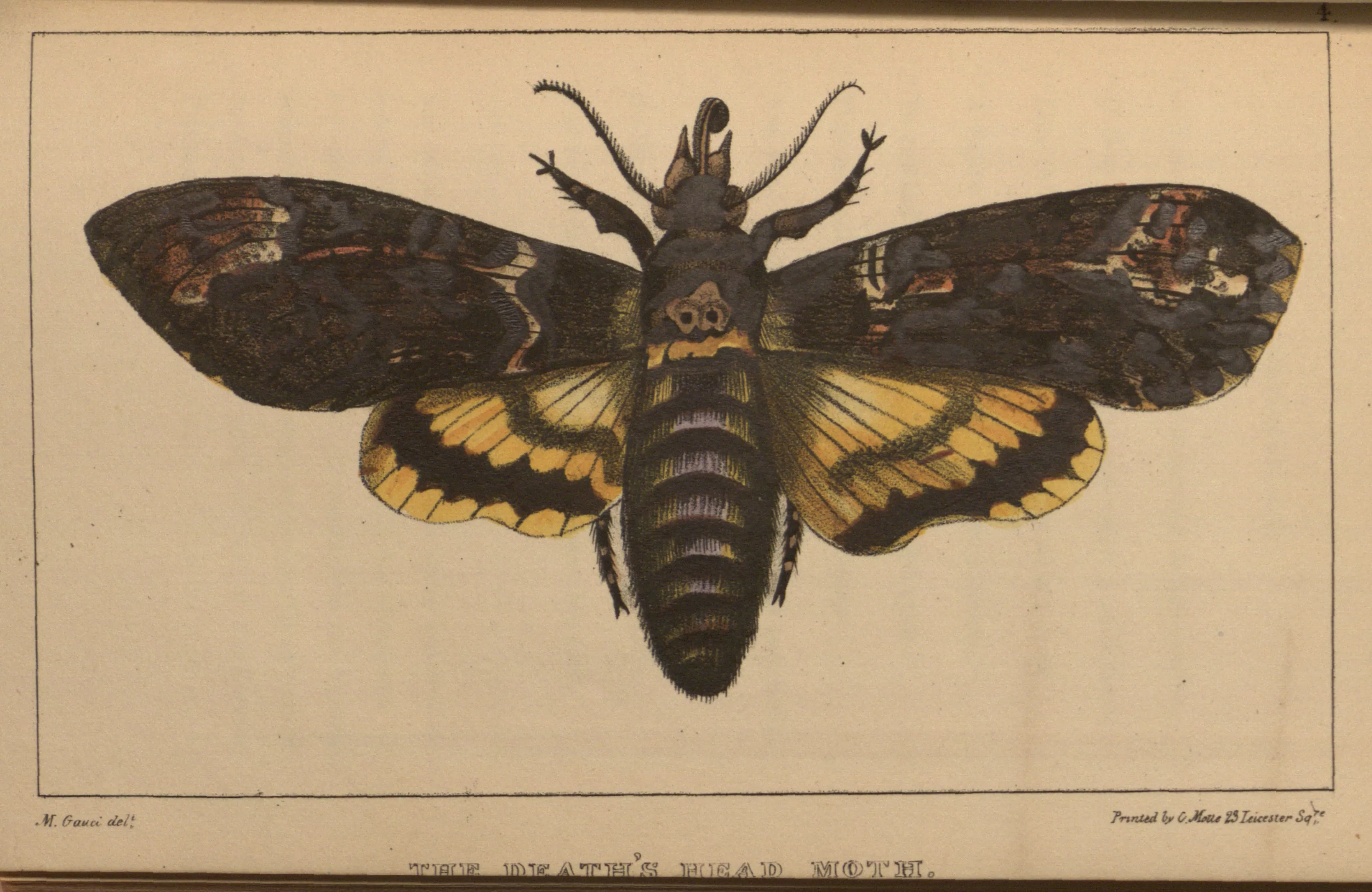Exhibit
Creation Date
1831
Height
6 cm
Width
12 cm
Medium
Description
This image depicts a death's-head moth on a white background, with wings outstretched.
In its vivid but stark depiction of a death's head moth, this illustration indicates the influence of Rousseau's thought on children's education: rather than relying on associationism, Rousseau's ideal education resisted the collaboration of fact and fantasy as potentially harmful.
In 1807, William Roscoe published The Butterfly’s Ball and the Grasshopper's Feast, a simple poem personifying creatures great and small. The book was immensely successful, selling 40,000 copies in its first year. Consequently, it inspired many imitations, one of which produced this illustration (MacNaughton).
The function of illustrations in children’s books varied depending on the pedagogical beliefs of those producing the work. Here, that function is primarily educational.
Though seen during the eighteenth century as the “poor relative” of natural philosophy because of its primarily descriptive nature, natural history had come into its own as a significant area for scientific study by 1800. Attention shifted from “a static natural history to a history of nature” (R. Yeo, “Natural Philosophy 325). Though still used as a catch-all term for the hobby of collecting and describing plants and animals, natural history now had intellectual direction as well, evidenced by its division into such subcategories as biology and comparative anatomy.
Public interest in natural history blossomed in the middle of the eighteenth century and remained strong well into the nineteenth. Adaptations of denser scientific works for the greater population, such as Oliver Goldsmith’s A History of the Earth and Animated Nature (1774), were eagerly embraced by an audience increasingly interested in the natural world (Ritvo 72). Natural history books for children began to appear in the later part of the eighteenth century, with Thomas Boreman’s A Description of Three Hundred Animals (1793) widely acknowledged as the first of its kind (73). The topic of natural history was seen as inherently attractive to young readers, consequently making it an ideal didactic and pedagogical instrument (74).
The starkness of the image and the lack of anything else with which to associate it indicates the possible influence of Rousseau on its visual project, as he disagreed with combining the fantastic and the real. While Emile was published in England in 1862, its influence was not felt until later; the first mention of Rousseau in a children’s book did not occur until 1783 (Bator 51). Unlike the book’s other images, which combine the educational and the fanciful, this depiction of the Death’s Head moth is devoid of anything that might stimulate the imagination. Both the other illustrations and the text take up Locke’s opinion that, for children, “Learning any thing . . . might be . . . as much a Recreation to their play, as their Play is to their Learning" (Locke); this illustration, conversely, leans towards Rousseau's thought, who felt that instruction and imagination should not be allowed to overlap. The radically different effect of this illustration points to the growing influence of Rousseau in education at the time.
Locations Description
Bradbury and Evans Publishing House was begun in 1830 by William Bradbury and Frederick Muller Evans as a printing house; it later became a bookseller's as well. Though they later directed the bulk of their efforts towards legal printing and the comic magazine Punch, The Emperor’s Rout (published for Charles Tilt) was one of their first works (Shillingsburg).
Collection
Accession Number
CA 8970
Additional Information
Bibliography
Bator, Robert. “Out of the Ordinary Road: John Locke and English Juvenile Fiction in the Eighteenth Century.” Children’s Literature 1 (1973): 46-53. Print.
Locke, John. Some Thoughts Concerning Education. London, 1963. Print.
Macnaughton, Donald A. “Roscoe, William (1753–1831).” Oxford Dictionary of National Biography. Ed. H. C. G. Matthew and Brian Harrison. Oxford: OUP, 2004. Web. 1 May 2009.
Patten, Robert L. and Patrick Leary. "Bradbury, William (1800–1869)." Oxford Dictionary of National Biography. Ed. H. C. G. Matthew and Brian Harrison. Oxford: OUP, 2004. Web. 1 May 2009.
Shillingsburg, Peter. "Bradbury and Evans." Victorian Web. Web. April 4 2009.
Ritvo, Harriet. “Learning from Animals: Natural History for Children in the Eighteenth and Nineteenth Centuries.” Children’s Literature 13 (1985): 72-93. Print.

